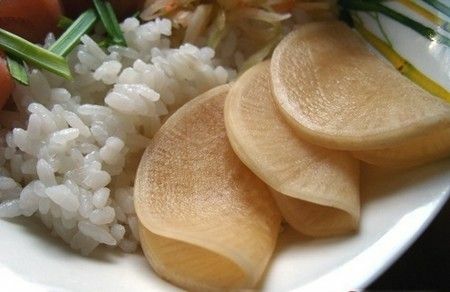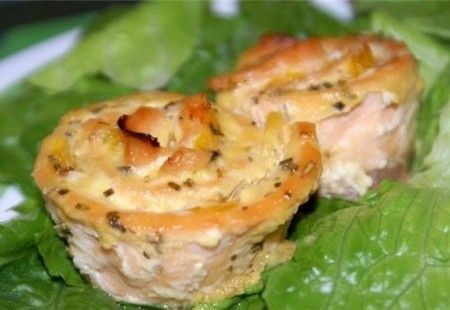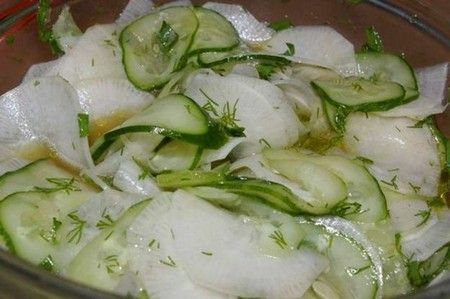Daikon is a root crop, once bred in China and resembling a radish or a big carrot. For these reasons, it is also called "Chinese radish".This vegetable has found a lot of admirers on the territory of different countries of the world and the inhabitants of Russia are no exception.

But it is valued not only for high taste qualities. A large number of important substances for the human body that make up its composition makes this root crop incredibly useful. From this article you will find out what the useful properties and contra-indications of the daikon are, and also you can choose for yourself several recipes for cooking this amazing vegetable.
How do I know daikon?
Daikon root looks like a big radish or carrots. Its length on the average reaches 30 cm, and the diameter is about 8 cm. Under favorable conditions, this vegetable can grow up to 60 cm in length and have a weight of 500 grams.
As seen in the photo above, the daikon is painted white. In taste, it is similar to the same radish, but due to the lack of mustard oil in its composition, it has a more pleasant aroma and mild taste.
This vegetable is one of the main ingredients of Japanese cuisine. It is served as a side dish, added to salads. The taste of radish daikon is perfectly combined with meat and fish dishes, it is often put in miso-soup and supplemented with sashimi.
Useful properties of
Now it is necessary to tell about what the benefit and harm of daikon is. And first we'll find out its properties.
- It contains vitamin C, which helps the body overcome colds and strengthens the immune system.
Tip! If you are still in search of a product in a small portion of which will contain a daily dose of vitamin C, then you have already found it. This daikon, and to fulfill the above conditions, you should eat a day only 300 g of this vegetable.
- Thanks to the presence of vitamin B, this root has a positive effect on the work of the central nervous system - it helps to normalize mental balance and restores concentration of attention.
- Potassium, present in this vegetable, is indispensable for health and strength of teeth, hair and bone tissue.
- This root helps to restore the liver and dissolves sand and stones in the kidneys.
- The presence of isorodic acid makes it possible to use daikon as a prophylactic agent of oncological diseases.
- Fiber makes it an indispensable product in dietary nutrition - a small portion gives a sense of satiety, which is enough until the next meal.
- Enzymes contribute to the breakdown of starch, an excess of which can lead to a set of excess weight.
- Phytoncides show bactericidal action and protect the body against infections.
- The calorie content of the daikon is insignificant - only 21 kcal per 100 g of product.
- If you use this vegetable in its raw form, you can cleanse the body of cholesterol, radioactive and toxic substances.
In the course of research conducted by scientists, it was found that the use of this root positively affects the health of patients suffering from diabetes and cardiovascular diseases. As an external agent it is recommended to use as compresses for wound healing, strengthening of hair and getting rid of freckles.
Contraindications
Radish daikon is of great benefit to the human body, but that it does not cause harm, you should know about the contraindications:
- disorders in the work of the gastrointestinal tract;
Important! A large amount of fiber, which is long digested in the body, can cause undesirable consequences.
- gastritis;
- stomach ulcer;
- gout;
- severe damage to the kidneys and liver.
Now you know what a daikon is useful, and in what cases its use is unacceptable. But in any case, before you include this vegetable in your daily diet, it is advisable to consult with a nutritionist.
What should I cook?
It is quite difficult to determine what the daikon - radish or radish looks more like for its taste qualities, but unlike them, this root is completely devoid of bitter taste. This fact allows you to use it in its raw form and include in vitamin salads. And most importantly, in this case, it will completely retain all its unique properties.
But not all recipes assume the use of daikon in raw form. This vegetable can be stewed, fried and marinated. And if you have not yet tried the "white radish", then we suggest that you correct this misunderstanding.
Marinated daikon in oriental
- Pour 50 ml of water into the container, add 50 g of sugar, 30 ml of apple cider vinegar, a pinch of turmeric.
- Put on the fire, bring the contents to a boil and after completely dissolving the sugar remove from the plate.
- 100 g daikon peel, cut into thin slices and salt.
- Transfer the prepared vegetable to a colander and leave for one hour. Important! This is necessary in order for the excess liquid to leave.
- After this time, rinse the daikon with water and dry the slices with a paper towel.
- Fold the root crop in a container of plastic or glass, pour in the marinade.
- Close tightly and shake the container several times.
- Leave to marinate overnight.

Rolls of trout with daikon
- 4 trout fillets, free of bones and skin, put on a board.
- 3 slices of garlic, 1 small piece of fresh ginger and 2 shallots onions finely chopped with a knife.
- Fold in a container, add juice and zest of one lime, 60 ml of soy sauce, 20 ml of liquid honey, 130 ml of olive oil, mix.
- Divide the marinade into two parts, one of which is seasoned with salt and white ground pepper.
- Pour the fillet seasoned with marinade, wrap each layer with rolls, wrap with two strips of smoked bacon and send to the refrigerator for 25 minutes.
- One medium daikon is cleaned and cut into thin slices using a special knife.
- 2 stalks of green onions cut into feathers, add it to the dikon, pour in the second part of the marinade, add salt, pepper.
- Take the pickled fillet and in each wrap a small amount of lettuce from daikon.
- Bake in the oven at 170 ° for 20 minutes.
Tip! These rolls can be prepared in any way acceptable to you: boil in a double boiler, grill or wrap in foil and boil in a saucepan.

Japanese salad
- 1 small root of daikon and 1 fresh cucumber cut into thin circles, salt.
- Transfer the vegetables to a colander and leave for 15 minutes to allow the glass to excess fluid.
- In a separate container, combine 2.5 tablespoons of sake, 5 tablespoons of rice vinegar and a small amount of water.
- Fry vegetables in a dish, pour over a prepared dressing, add salt, add a tablespoon of sugar, mix.

Add daikon to various dishes, create your own recipes and be healthy.
